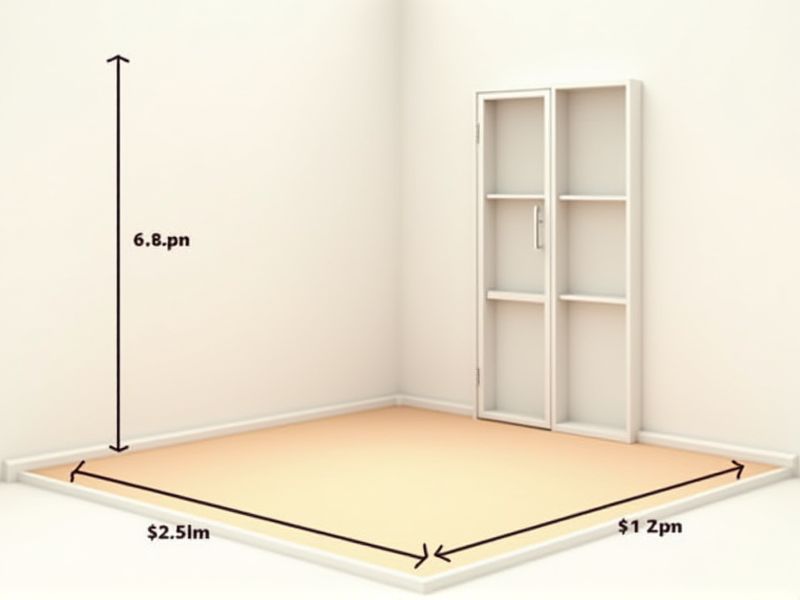
Standard room dimensions can vary depending on the type and purpose of the space, but there are generally accepted averages that are helpful for planning. For example, a typical bedroom is usually about 10 feet by 12 feet (3 meters by 3.6 meters), providing comfortable space for furniture and movement. Living rooms often range from 12 feet by 18 feet (3.6 meters by 5.5 meters), allowing for seating arrangements and entertainment areas. When designing or remodeling, using these standard measurements as a reference ensures functionality and helps with furniture placement and overall room flow.
Ceiling Height
Ceiling height plays a crucial role in the overall perception of space within a room, significantly affecting both aesthetics and functionality. In residential design, a minimum ceiling height of 8 feet is generally recommended to ensure comfort and a sense of openness. However, higher ceilings, often exceeding 10 to 12 feet, can enhance natural light distribution and improve airflow, making spaces feel more expansive. When planning your interior layout, consider how ceiling height impacts not only visual appeal but also acoustic performance, especially in larger rooms.
Room Length
The standard room length for residential spaces typically ranges from 10 to 12 feet, providing adequate space for various furniture arrangements. In commercial settings, room lengths of 15 to 20 feet are common to accommodate larger gatherings or equipment. You should consider that a longer room enhances natural light and airflow, creating a more comfortable environment. Rooms exceeding 20 feet can be designed to create distinct zones, optimizing functionality while maintaining a cohesive aesthetic.
Room Width
Room width is a crucial aspect of interior design, impacting functionality and aesthetics. For optimal usage, a minimum width of 10 feet is recommended for comfortable movement and furniture arrangement in living spaces. In bedrooms, a width of at least 12 feet is ideal to accommodate a queen or king-sized bed, along with bedside tables. Ensuring proper room width not only enhances the living experience but also contributes to effective spatial planning and design flexibility.
Door Dimensions
The standard door dimensions typically measure 80 inches in height and 36 inches in width for entry doors in residential buildings, ensuring accessibility and ease of use. For interior doors, a common size is 80 inches by 28 or 30 inches, accommodating various room layouts. Maintaining these dimensions is crucial as they influence factors like furniture placement and circulation space within your home. When considering door installation, always check local building codes, which may define specific requirements based on your region.
Window Size
Room standards often dictate window size for optimal natural light and ventilation. Ideally, windows should comprise at least 10% of the floor space to ensure adequate illumination and air flow. In residential settings, the American National Standards Institute (ANSI) recommends a minimum window size of 5 square feet for rooms larger than 100 square feet. By prioritizing larger windows, you can enhance your living space's energy efficiency while promoting a connection to the outdoors.
Wall Thickness
Wall thickness is a vital factor in room design, directly impacting thermal insulation and soundproofing. For residential spaces, a minimum wall thickness of 4 to 6 inches is often recommended to balance structural integrity and energy efficiency. In commercial settings, walls may need to exceed 6 inches to accommodate electrical installations and provide adequate acoustic performance. Ensuring optimal wall thickness not only enhances indoor comfort but also contributes to long-term savings on energy costs.
Floor Depth
The standard room floor depth typically ranges from 10 to 12 feet, allowing for optimal airflow and natural light penetration. A well-designed floor depth can enhance acoustic performance, reducing noise infiltration from adjacent spaces. The ideal floor depth not only accommodates furniture layout but also supports effective heating and cooling, impacting energy efficiency. For your comfort, consider how variations in floor depth can influence the overall spatial experience and functionality of your living area.
Electrical Outlet Placement
An ideal electrical outlet placement in a standard room typically requires positioning outlets every 6 to 12 feet along walls to ensure accessibility and convenience. In areas like kitchens and offices, codes often recommend additional outlets, with a minimum of two at each countertop or workspace, ensuring you can plug in appliances and devices easily. Outlets should be installed at a height of about 12 to 18 inches above the floor, allowing for easy access without interfering with furniture placement. Remember, strategically placed outlets can enhance safety by reducing reliance on extension cords, which pose tripping hazards.
Hvac Vent Location
Proper HVAC vent location is crucial for optimal room climate control, enhancing both comfort and energy efficiency. Ideally, vents should be positioned near windows or exterior walls to counteract drafts and maintain a consistent temperature. For every 500 square feet of space, ensure at least one vent to promote adequate air circulation. Consider using adjustable vents to tailor airflow to your specific needs, improving overall performance and comfort in your living environment.
Lighting Fixture Position
Properly positioning lighting fixtures significantly enhances the ambiance and functionality of your room. For optimal results, place fixtures approximately 30 to 36 inches above work surfaces or tables, ensuring adequate illumination without harsh shadows. In areas such as living rooms, aim for a mix of overhead, floor, and table lamps to achieve a balanced light distribution, typically utilizing 200-300 lumens per square meter (lux). Consider dimmable options to adjust brightness levels according to different activities, allowing for versatility in your living space.
